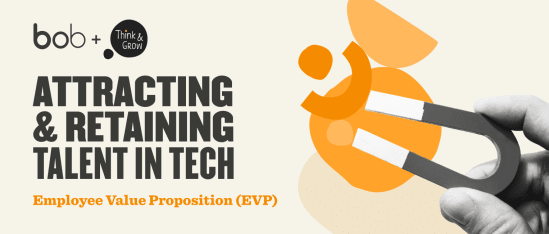As we adjust to a post-COVID world, companies need to evolve according to changes in the workplace and their people’s expectations, which are no longer considered ‘perks’ but essentials. Culture, employee stock ownership (ESOP), and diversity and inclusion processes are now being redefined as companies struggle to hire the best tech talent, keeping market dynamics interesting.
Together with HiBob, we recently hosted events in Sydney and Melbourne focused on attracting and retaining tech talent. In these sessions, we discussed several strategies that companies can use to help them achieve this goal. In this blog, we’ll discuss the first one, which is creating an employee value proposition (EVP) to attract talent and keep them happy and engaged.
While creating an EVP shows that you care about your people and want to provide them with a generous offering of benefits and rewards, it’s important not to get dragged into a benefits battle for the sake of trying to stay current. Here are some ideas for how you can generate an EVP that comes across as authentic while staying true to your company’s core values.
Challenge 1: How to make your EVP come across as authentic
Creating your EVP and its associated benefits can sometimes come across as gimmicky and as if they’ve been thrown together without much consideration for their impact. For example, making statements such as “we’re advocates for flexible working” may miss the mark. Taking the time to describe what that means and why you’ve introduced this benefit as part of your EVP, is just as important as the benefit itself.
Solution 1: Communicate your North Star metric and build your EVP around it.
Your North Star is your key measure of success, so use it to build your EVP. Consider your company’s priorities and then ask yourself what your team needs from your EVP to tick off those priorities.
Prospective employees will also want to know your North Star metric and not only how you see them helping you reach it, but also what you’re going to provide them with to help them to help you.
Solution 2: Share what actually matters to you and your employees and why.
Our work and personal lives are blended in more ways than ever before. The fact is, we all have a life and people we love that are incredibly important to us. Showing you care about your people’s personal lives will remove any gimmicks or inauthenticity around your EVP.
For example, you can introduce calendar transparency as part of a flexible working model. Your employees may have things they need or want to do during the day, such as clocking out early to pick up a child from school or blocking out two hours for a lunchtime gym session, or taking a day off to look after a sick dog. Whatever their reasons, they shouldn’t need to hide or lie about what they are doing.
A company that is open and encourages its people to do the things that are important to them, shows that they acknowledge their people and their needs, and that life isn’t just about work. Because the truth is, it isn’t.
Challenge 2: How to have an EVP that stands out from your competitors
When it comes to the benefits battle, employees are being bombarded with options. An EVP is a great way to pitch yourself away (and above) from your competitors. But, you should think about your offering carefully. Here’s how to create and communicate an EVP with a difference.
Solution 1: Competitor research—what can you do differently and why?
This may sound obvious, but you’d be surprised at how few companies take the time to do this. Research your competitors and find out what they’re offering as part of their EVP, and why and what impact this has on their talent acquisition and retention success.
Consider what you can offer that’s different and will be more beneficial to your employees. If you’re offering something similar to other companies, then how can you communicate and pitch it differently so that it sounds more relevant and attractive? Try to communicate the essence of your company in a few paragraphs, highlighting what makes you truly unique. This should help in sharing the integrity and trust that comes out of an EVP.
Solution 2: What do you think is missing?
Sometimes competitor research can become overwhelming and offer too many unwelcome ideas that are too far removed from your core values. In this case, go back to those core values and you.
Ask yourself these questions: What would do you think is missing from your EVP? What would make you stay at this company from an EVP perspective? What would make you feel proud to work here? What would be desirable to you if you were interviewing at this company?
Challenge 3: How to create an EVP that current and future talent actually wants
Creating EVP strategies used to be like hitting copy and paste, but candidates can see through that now, especially when companies are continuing to raise the bar. So how do you get ahead?
It sounds simple, but the first step is tailoring your EVP to what your talent actually wants. To go above and beyond means removing the guesswork and putting effort into discovering the truth. This will help you have a better aim for your targeted talent.
Solution 1: Give them purpose in their role and future career moves
Let’s talk about attracting tech talent, for example, engineers. Interview your current engineers or even previous engineer candidates to understand what they care most about in solving problems and building your product. This will help you get a clearer picture of what attracted them to this role and your company. You can then use this information when writing job ads, and describe in detail the role’s purpose and the part candidates can play in the company’s success. You can also go one step further and create a blog post on your EVP, and ask your product team to share it online on different forums, Linkedin, GitHub, etc. to help source more like-minded engineers.
You can also use, learning and development opportunities to attract talent. Showing that you are invested in furthering your employees’ careers makes you very attractive as an employer and adds to creating a sense of belonging and community that’s essential for talent retention.
Recommended For Further Reading
Solution 2: Don’t be afraid to move with the times
We’ve already seen the drastic changes that the pandemic has introduced—the hybrid office and remote working is a key example. This means that a stagnant EVP will become outdated and ineffective fairly quickly. One way to overcome this is to run an EVP-specific survey of employees after their probation period.
Collect their insights on how your EVP was communicated to them, how authentic they felt it was at the time, and how they feel about it now. What are the differences in how it was presented to them before they joined, and after working for 3-6 months in the company? These insights can be invaluable for creating an EVP that is relevant and current.
In summary…
- Make your EVP as authentic to your company’s values as possible by basing it on your North Star metric and figuring out what’s most important to your employees and why.
- Create an EVP that stands out from competitors by doing competitor research and asking yourself what you feel is missing.
- Communicate an EVP that talent actually wants to see by giving them purpose in their role and future career moves and be proactive rather than reactive when it comes to making changes.
This article has been posted in partnership with Think & Grow.

From Dan Spencer
Dan is an executive search and talent specialist with a 20+ year career across the Digital, Technology, Advertising, and Media landscape. When not working, he is trying to keep fit and hangs out with his wife and three kids.

